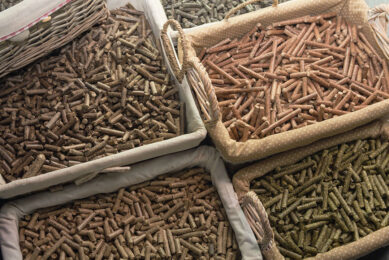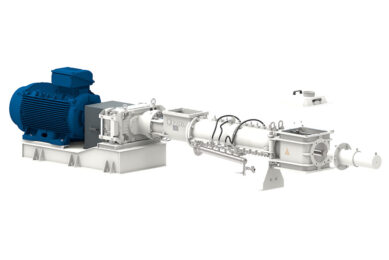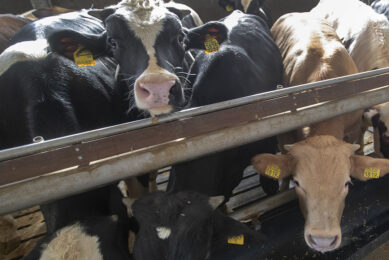Industrial Compound Feed Production
Annual production of compound feed in Germany is very stable. Since 1995/96 average production circles around 19 million tonnes.
replacers ››
With a production of 21.3 million tonnes German compound feed production
reached a new high in marketing year 2007. This volume includes 934,000 tonnes
of milkreplacers and feeds for other animals. The positive development is a
result of a sharp rise in red meat consumption and production. Demand has been
driven by a significant increase in compound feed for pigs and cattle by 708,000
tonnes or 8.7% to a total of 8.85 million tonnes in 2007.
The demand for compound feed – in particular in types of feed – varies from
time to time following changes in markets, changes in number of animals, changes
in legislation (e.g. use of meat and bone meal) and the availability of farm
grown raw materials.
 |
| Source: Fefac |
Compound feed for cattle supplies around 15% of the energy needs of the
ruminants. The demand for cattle feed shows a declining trend that started in
the early nineties of the previous century. Obviously this was caused by the
then emerging BSE-crisis and the milk production limiting milk quota under EU
milk market legislation.
Compared to last year, about 4.8% of the cattle farms in Germany stopped.
Total cattle numbers fell 0.5%. Despite these negative numbers the total number
of dairy cows increased slightly to 4.06 million (+0.2%). The biggest drop in
cattle was in the female beef cows, which decreased to 70,000 head or
-19.4%.
Cattle feed saw a significant increase, from 5.97 million tonnes 2006 to 6.38
million tonnes in 2007 or an increase of 6.9%. Cattle feed now is the second
most important compound feed produced in Germany with a share of almost 30% of
the total feed market. With the strong demand for milk this trend is likely to
continue.
 |
Source: |
Due to an outbreak of swine fever in 1996 the number of pigs in Germany
declined from 26.16 million head in 1992 to 23.55 million head in 1996. Since
then the number has been steadily rising. Little more pigs were kept as a year
ago according to the livestock census of November 2007. A total of approximately
26.95 million pigs were recorded, up 128,000 animals or 0.5% more than in
November 2006.
The number of fattening pigs increased by 1% or 115,000 to 11.13 million
animals. At the moment of counting about 6.74 million pigs stayed in the
stables, 0.8% more than a year earlier. Despite the increase Germany is still
under sufficient in pork production.
A contrary movement was seen in the development of breeding sows. Their
numbers fell by 2.3%. The stock of gilts was as much as 6.4% lower than in
November 2006.
One of the drivers of the feed production increase in Germany was the
significant rise compound feed for fattening pigs by 708,000 tonnes or 8.7% to a
total of 8.85 million tonnes in 2007. Pig feed takes 41.4% of the total feed
market in Germany.
Compound feed is responsible for about 35% of the energy needs of the pigs in
Germany. The remaining 65% (about 13 million tonnes) is mostly coming from farm
grown raw materials, mainly cereals such as wheat and barley, and to a lesser
extent from purchased soy cake (about 1.5 million tonnes)
 |
Source: |
German consumers were keener in purchasing poultry meat in 2007. Consumption
rose around 8%, and almost reached the level of 2005 again. This increase in
consumption was not reflected in an increase in feed production. Most of the
extra consumption was imported. Poultry feed production slightly decreased from
5.26 million tonnes in 2006 to 5.18 million tonnes in 2007 or a minus of 1.5%.
The effect was mainly caused by a decrease in the production of broiler feed
(-3.2% to 3 mill. t).
Layer feed
Industrial compound feed production is
responsible for around 82% of feed consumption of German poultry (layers and
meat birds). Germany houses approximately 39 million laying hens. However, the
decision to phase out battery cages and the transition to free range and barn
housing are clear indications for a reduction of this number. This also implies
a reduction in demand for layer feed. Currently layer feed production is around
2.1 million tonnes.
 |
Source: Fefac |
German horse lovers keep about 500,000 horses, ponies, and
fillies, mainly for equestrian activities or for leisure. The compound industry
annually serves this market with 265,000 tonnes of compound feed for horses.
Apart from farm animals there many more animals to feed that make use of the
products of the compound feed industry. This group contains a wide variety of
animals, such as dogs and cats, birds, reptiles, fish, zoo and laboratory
animals. Production of feed for these animals annually lays around 350,000
tonnes. Although this volume is only a small portion of total production, the
margins are much higher.
 |
Source: Fefac |
The number of compound feed manufacturers in Germany in 2007 fell by 9 to 352
reporting firms. Increased production and the reduced number of producers have
led to a further increase in average production capacity of 3,500 tonnes to
58,777 tonnes per feed producer per year.
The number of manufacturers with an annual production of over 200,000 tonnes
of feed remained constant with 30 enterprises. Total volume of production of
these companies rose by 200,000 tonnes to 9.1 million tonnes. The average annual
production reached 303,311 tonnes per plant. These group of manufacturers
represent 44% of the German market. Ten companies have an annual production of
more than 300,000 tonnes and together (4.1 million tonnes) represent almost 20%
of the market.
Next in size are enterprises with a production between 50,000 to 200,000
tonnes (85) which take almost 42% of the German market.
Join 26,000+ subscribers
Subscribe to our newsletter to stay updated about all the need-to-know content in the feed sector, three times a week. Beheer
Beheer










 WP Admin
WP Admin  Bewerk bericht
Bewerk bericht